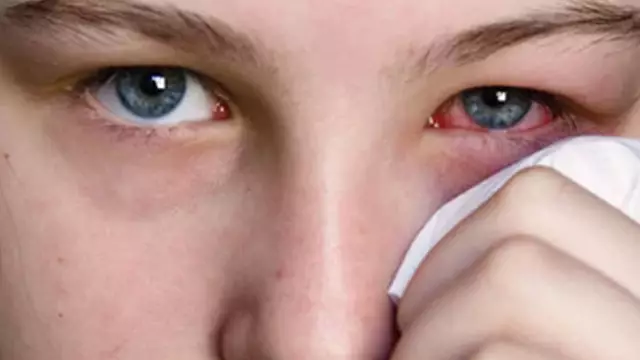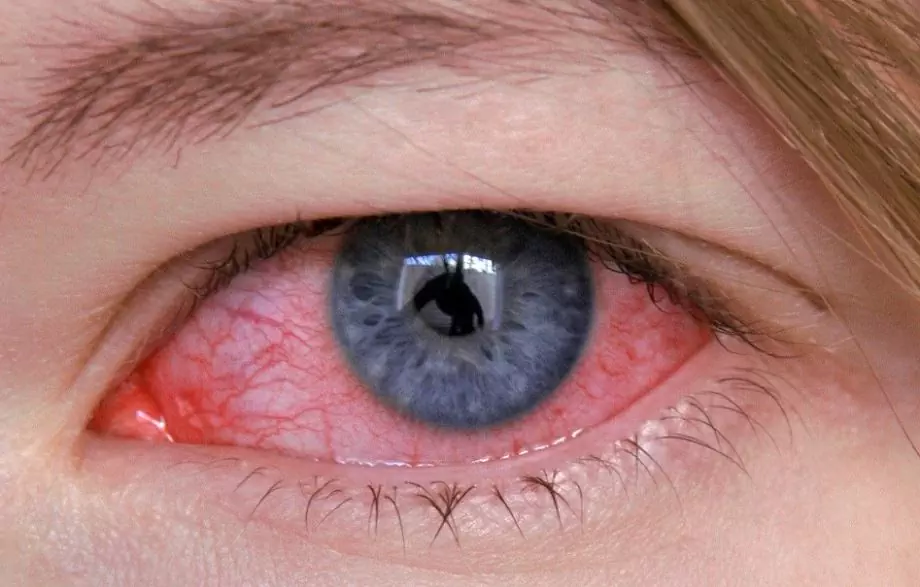- Author Rachel Wainwright [email protected].
- Public 2023-12-15 07:39.
- Last modified 2025-11-02 20:14.
Conjunctivitis in children, treatment

Conjunctivitis is an inflammation of the clear membrane of the eye, called the conjunctiva, caused by various pathogens and irritants. Children are more susceptible to this disease than adults.
The treatment of conjunctivitis in children is a difficult and at the same time urgent task. The eyes are one of the most unprotected organs, and it is always difficult for a child to keep from rubbing them during inflammation. That is why the treatment of this disease in babies is a difficult test for parents.
Features of conjunctivitis in children
The conjunctiva is a mucous membrane that envelops the outer surface of the eyeball along with the inner surface of the eyelids. It is washed by tear fluid, covered with eyelids and protects the delicate tissue of the human eye.
The conjunctiva can become inflamed when:
- Eye contact with sand, dust;
- Minor trauma to the eye;
- Decrease in the general immunity of the body as a result of any disease;
- The presence of an allergic reaction in the body;
- Disruption of normal tearing;
- Infection with infection.
According to the etiology of infection, the medical classification divides conjunctivitis into three main types:
- Viral;
- Bacterial;
- Allergic.
To choose the right treatment for conjunctivitis in children, you need to know what causes the disease.
Viral conjunctivitis in children, treatment
Viral conjunctivitis in babies occurs against the background of influenza or other viral infection, such as herpes. The virus that struck the body provokes inflammation of the conjunctiva, which is expressed by the following symptoms:
- First, the infection affects one eye, then the infection passes to the other;
- The eyes become red, irritated;
- Tears flowing profusely, like a child crying;
- A purulent exudate is formed in the case of a secondary, bacterial viral infection.
There is an opinion that viral conjunctivitis in children does not require treatment, since it goes away on its own as it recovers. However, to avoid complications, it is best to take timely remedial action.
For this, it is recommended to use drops containing interferon, such as ophthalmeron, actipol, poludan or eye ointments - bonafton or florenal. Before using medications, you need to rinse the child's eyes from secretions with infusion of sage, chamomile or cooled boiled water.
Treatment of purulent conjunctivitis in children
Conjunctivitis is called purulent, which is caused by infection with bacteria. Most often, children bring in such an infection with dirty hands when they rub their eyes, while pathogenic bacteria enter the mucous membrane. In case of bacterial infection, the treatment of conjunctivitis in children should be carried out especially carefully, following all the doctor's recommendations, in order to avoid complications.
The causative agents of this disease in most cases are pneumococci, staphylococci, chlamydia, gonococci, streptococci.
The first signs of bacterial inflammation of the eye mucosa are:
- Severe edema of the lower eyelids;
- Rapid manifestation of purulent discharge;
- Pus sticking of the eyelids, especially after sleep;
- Hyperemia of the eyes;
- Damage to the eyes at the same time or sequentially one after the other, with a small interval;
- Lachrymation;
- Photophobia.
Bacterial conjunctivitis often affects newborns. The infection gets into their eyes when the babies pass through the birth canal, especially if the mother is at risk or hygiene standards are violated in the maternity hospital. The cause of the disease can also be a congenital pathology of the lacrimal ducts. Babies born prematurely are also more susceptible to bacterial infection.
Comprehensive treatment of purulent conjunctivitis in children includes:
- Antibiotics in special eye drops or ointments;
- Eye ointments containing sulfonamides;
- Decoctions of anti-inflammatory herbs for washing the eyes from purulent discharge;
- Eye drops containing anesthetics if the child has severe photophobia or eyelid compression syndrome.
In case of a bacterial form, Dr. Komarovsky advises treating conjunctivitis in children with a solution of the drug "Tsiprolet" based on saline.
Treatment of allergic conjunctivitis in children
Allergic conjunctivitis occurs as a reaction of the eyes to certain stimuli. They can be dust particles, animal hair, plant pollen, medicines, household chemicals, food products. With this form of the disease, both eyes become inflamed at the same time. The main symptoms are:
- Itching;
- Redness of the eyes;
- Swelling of the lower eyelids;
- Lachrymation.
With this form, Dr. Komarovsky recommends combining the treatment of conjunctivitis in children with tests to identify the allergen in order to protect the child from the effects of an irritating factor and for effective therapy.
As symptomatic treatment are used:
- Antihistamine eye drops;
- Anti-inflammatory medicines;
- Hormonal eye ointments;
- Antihistamines;
- Cool lotions on the eyes.
Conjunctivitis is most difficult to treat in infants. If the baby does not open his eyes when instilling drops, you need to carefully pull off the lower eyelid with clean fingers - this will help the medicine get to the mucous membrane.
Alternative treatments for conjunctivitis in children
Of the many existing folk methods for treating eye inflammation, it is actively used:
- Rinsing with boiled water with the addition of aloe juice;
- Cleansing with freshly brewed black or green tea;
- Instilling herbal preparations and washing the child's eye with them. Chamomile, nettle, sage are used as medicinal herbs;
- Purification of pus with dill juice. You can make dill lotions;
- Applying compresses from a tincture of bay leaves. They are anti-inflammatory and effective in relieving swelling.
The child needs to rinse his eyes in the direction from the outer corner to the inner corner. It is recommended to make swabs for washing from a bandage so that the cotton fibers do not irritate the mucous membrane. A separate disposable swab is used for each eye.
The time-tested alternative treatment of conjunctivitis in children is completely harmless and gives good results.
How to protect a child from conjunctivitis

To protect your baby's eyes from infection, you should:
- Always have an individual baby towel and other everyday items;
- Wash your child's hands thoroughly with soap;
- Do not touch his eyes with your own hands, and teach the baby to use a clean napkin or scarf for this;
- Ventilate the nursery regularly;
- Give your child more fruits and vegetables;
- Eliminate foods that cause allergies;
- Wipe dust off the floor and furniture in a damp cloth for children;
- Engage in physical exercise and tempering with children.
You should immediately consult a doctor at the slightest suspicion of conjunctivitis in children, it is important to start treatment on time to avoid complications in the future.
Found a mistake in the text? Select it and press Ctrl + Enter.






